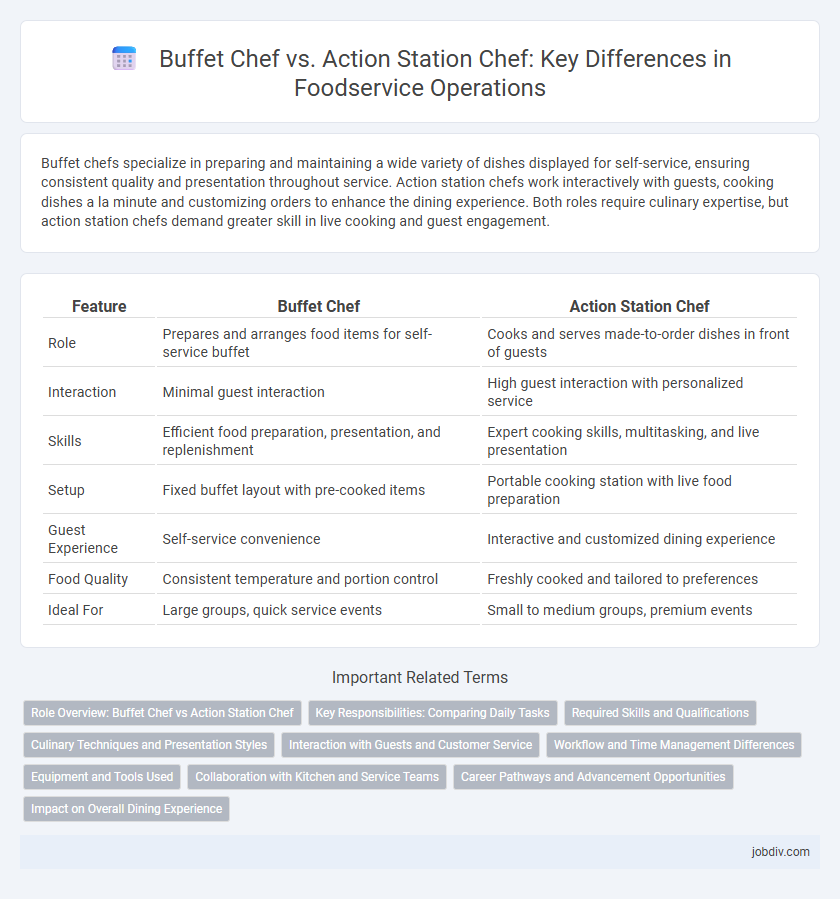Buffet chefs specialize in preparing and maintaining a wide variety of dishes displayed for self-service, ensuring consistent quality and presentation throughout service. Action station chefs work interactively with guests, cooking dishes a la minute and customizing orders to enhance the dining experience. Both roles require culinary expertise, but action station chefs demand greater skill in live cooking and guest engagement.
Table of Comparison
| Feature | Buffet Chef | Action Station Chef |
|---|---|---|
| Role | Prepares and arranges food items for self-service buffet | Cooks and serves made-to-order dishes in front of guests |
| Interaction | Minimal guest interaction | High guest interaction with personalized service |
| Skills | Efficient food preparation, presentation, and replenishment | Expert cooking skills, multitasking, and live presentation |
| Setup | Fixed buffet layout with pre-cooked items | Portable cooking station with live food preparation |
| Guest Experience | Self-service convenience | Interactive and customized dining experience |
| Food Quality | Consistent temperature and portion control | Freshly cooked and tailored to preferences |
| Ideal For | Large groups, quick service events | Small to medium groups, premium events |
Role Overview: Buffet Chef vs Action Station Chef
A Buffet Chef is responsible for preparing and presenting a variety of dishes in a self-service style, ensuring consistent quality and replenishing items throughout the service period. An Action Station Chef specializes in live cooking, engaging guests by preparing customized meals on demand, often requiring advanced culinary skills and quick execution. Both roles prioritize food safety and presentation but differ in interaction level and cooking dynamics within foodservice environments.
Key Responsibilities: Comparing Daily Tasks
Buffet chefs manage large-scale food preparation, ensuring consistent quality and presentation for multiple dishes served simultaneously in self-service settings. Action station chefs focus on interactive cooking, preparing made-to-order dishes in front of guests, requiring strong multitasking and customer engagement skills. Both roles demand expertise in food safety, ingredient preparation, and time management, but buffet chefs prioritize volume efficiency while action station chefs emphasize personalized culinary experiences.
Required Skills and Qualifications
Buffet chefs require expertise in large-scale food preparation, presentation, and ensuring consistent quality across diverse dishes, emphasizing speed and efficiency. Action station chefs must excel in culinary skills, live cooking techniques, and customer interaction, often specializing in specific cuisines or dishes prepared on demand. Both roles demand strong knowledge of food safety standards, time management, and adaptability to high-pressure environments.
Culinary Techniques and Presentation Styles
Buffet chefs specialize in large-scale food preparation with consistent plating techniques, ensuring dishes are visually appealing and easily accessible for self-service. Action station chefs employ interactive cooking methods, such as grilling or sauteing on demand, enhancing freshness and allowing customization while focusing on dynamic presentation that engages guests. Both roles require mastery of culinary skills, but action station chefs prioritize live cooking spectacle and personalized service, contrasting with the buffet chef's emphasis on uniformity and volume.
Interaction with Guests and Customer Service
Buffet chefs primarily focus on maintaining food quality and presentation, with limited direct interaction with guests, ensuring a seamless and efficient self-service experience. In contrast, action station chefs engage guests through live cooking demonstrations, offering personalized meal options and fostering immediate communication for special dietary requests. This interactive approach enhances customer satisfaction by creating memorable dining experiences and addressing individual preferences in real-time.
Workflow and Time Management Differences
Buffet chefs focus on preparing large quantities of dishes ahead of service, ensuring consistent presentation and easy replenishment, which demands efficient batch cooking and inventory management. Action station chefs work in front of guests, requiring dynamic multitasking and quick adaptation to customized orders, emphasizing real-time cooking and seamless coordination with front-of-house staff. Workflow for buffet chefs emphasizes predictability and volume control, while action station chefs prioritize speed, interaction, and flexible time management to handle fluctuating demand.
Equipment and Tools Used
Buffet chefs primarily use warming trays, chafing dishes, and large serving platters to ensure food remains at optimal temperatures and is easily accessible for guests. Action station chefs rely on portable cooking equipment such as induction burners, grills, and saute pans to prepare dishes live, offering fresh and customizable options. Both roles require specialized tools, with buffet chefs focusing on heat retention and presentation, while action station chefs emphasize versatility and immediate cooking capabilities.
Collaboration with Kitchen and Service Teams
Buffet chefs synchronize closely with kitchen teams to ensure a consistent supply of prepared dishes, maintaining quality and presentation at all times. Action station chefs collaborate dynamically with both kitchen and service staff, adapting in real-time to customer preferences and dietary requirements while ensuring swift, personalized food preparation. Their joint efforts optimize workflow efficiency, enhance guest satisfaction, and uphold food safety standards throughout the service period.
Career Pathways and Advancement Opportunities
Buffet Chefs often begin their careers mastering large-scale food preparation and presentation, gaining expertise in menu planning and inventory management, which can lead to supervisory roles in banquet or catering operations. Action Station Chefs specialize in interactive cooking techniques and live food preparation, developing skills that open pathways to positions such as sous chef or chef de partie in high-end restaurants or hotels. Both roles offer advancement opportunities through culinary certifications and leadership experience, with Action Station Chefs typically progressing faster due to the high demand for skilled chefs in dynamic, guest-focused environments.
Impact on Overall Dining Experience
Buffet chefs ensure a seamless flow of diverse, pre-prepared dishes that maintain consistent quality and presentation, enhancing the efficiency of large-scale dining events. Action station chefs create an interactive experience by preparing customized dishes on demand, adding a dynamic and engaging element that heightens guest satisfaction. The choice between buffet and action station chefs directly influences guest perception, balancing speed and personalization to optimize the overall dining experience in foodservice settings.
Buffet Chef vs Action Station Chef Infographic

 jobdiv.com
jobdiv.com